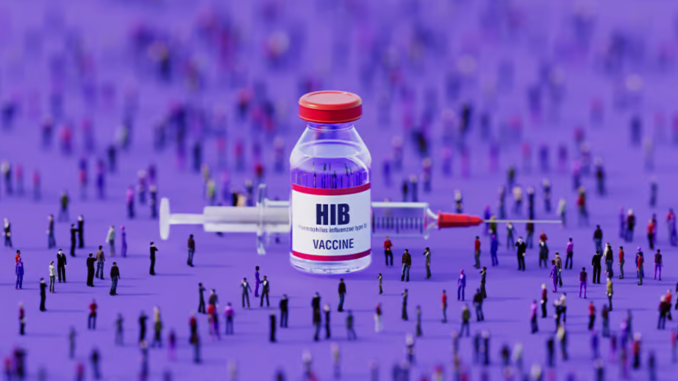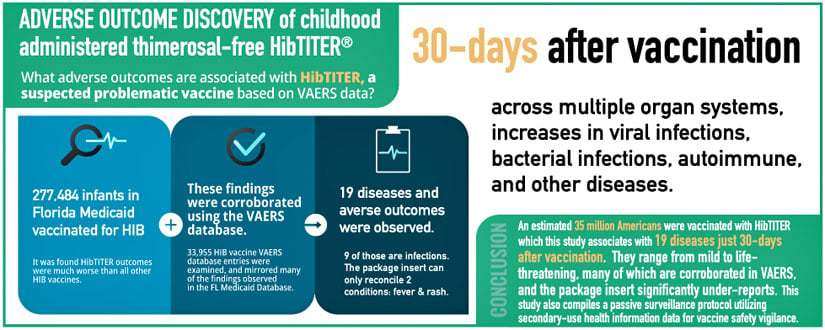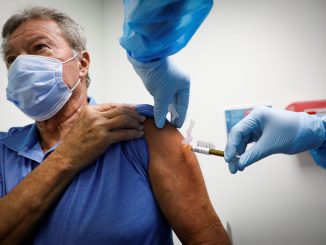
Original Article by Brenda Baletti, Ph.D.
The thimerosal-free HibTITER pediatric vaccine marketed by Wyeth from 2003 through 2007 was associated with 19 different medical conditions, according to a study published Tuesday in the International Journal of Risk & Safety in Medicine.
The conditions include life-threatening side effects at rates “significantly higher” than other Hib vaccines.
The study, by Children’s Health Defense (CHD) researcher Karl Jablonowski, Ph.D., and Brian Hooker, Ph.D., CHD chief scientific officer, compared adverse events among children who received HibTITER to those among children who received other Hib vaccines.
Haemophilus influenzae type b (Hib) is a bacterium that can cause illnesses ranging from ear infections to pneumonia to meningitis. Vaccines for Hib in young children were first licensed in 1987. The Centers for Disease Control and Prevention (CDC) recommends Hib vaccines for infants at age 2 months.
Wyeth, now Pfizer, sold HibTITER from the time it was licensed in 1990 until 2007. In 2003, the company reformulated the vaccine to remove thimerosal, a type of mercury, after public outcry over the dangers of mercury in vaccines.
In 2007, Pfizer “quietly” pulled the reformulated HibTITER vaccine off the market, Hooker told The Defender — a move he said was concerning, in light of the vaccine’s “relationship to many adverse events in children.”
To assess those adverse events, Jablonowski and Hooker analyzed data from 277,484 children between 2003-2007 — when the thimerosal-free HibTiTER was available — using the publicly available Florida Medicaid database.
They corroborated their findings by analyzing data for the vaccine from the Vaccine Adverse Event Reporting System (VAERS), a passive public reporting system jointly administered by the CDC and the U.S. Food and Drug Administration (FDA).
The researchers identified medical conditions for infants vaccinated with any Hib vaccine within 30 days of the shot. The Medicaid data revealed 19 different diagnoses associated with HibTITER at frequencies significantly higher than those associated with other Hib vaccines. They also verified 14 of those diagnoses in VAERS.
The adverse events, ranging from mild to life-threatening, included respiratory, gastrointestinal, dermatologic and generalized infections; ear, nose and throat medical contitions; and other conditions.
None of the serious or even life-threatening conditions identified were listed as possible adverse events on the package insert for HibTITER.
The authors’ findings “have profound medical implications for the estimated 35 million Americans between the ages of 16 and 33 who received the vaccine,” they wrote.

VAERS ‘screaming’ problem with HibTITER for decades
The first Hib conjugate vaccine, which combines a weak antigen with a stronger one to elicit a more robust immune response to the weak antigen, was licensed in 1987 for children 18 months and older, and in 1990 for infants 2 months and older.
Following the approval of the first Hib conjugates, rates of Hib disease in young children dropped dramatically — 92%, from 37 per 100,000 in 1989 to 3 per 100,000 by 2008.
While numerous safety studies found the vaccine to be safe and the side effects to be transient, Jablonowski and Hooker wrote that those studies were “underpowered” — meaning the sample sizeswere too small to detect potential safety issues.
The clinical trial used to declare the vaccine’s safety consisted of investigators calling families 72 hours after vaccination to see how the infants were doing. On that basis, they concluded the vaccine was “safe and effective,” the authors wrote.
“Since VAERS first went live in July of 1990 the data started screaming that something was wrong with HibTITER,” Jablonowski told The Defender. “In VAERS’ first six months of existence, 30% of mortalities reported in children 6 months old or younger were HibTITER recipients.”
HibTITER dominated the Hib vaccine market between 1991 and 1994 when it began to share the market with other FDA-approved vaccines.
Wyeth allowed the license for the thimerosal-containing HibTITER to expire in 2002, following the CDC’s Simpsonwood retreat. At the meeting of public health officials, vaccine manufacturers and professional medical associations reviewed data from the Vaccine Safety Datalink and privately raised concerns about thimerosal in vaccines.
The license expired just after the Institute of Medicine’s Immunization Safety Review Committee published its 2001 safety review of thimerosal-containing vaccines and their link to neurodevelopmental disorders.
In that report, the Institute of Medicine found insufficient data to confirm or deny the link, yet the CDC recommended removing thimerosal from vaccines “as soon as possible.”
However, even when Wyeth began selling a reformulated non-thimerosal version of HibTITER in 2003, adverse events continued to occur at high rates.
“In the subsequent years, HibTITER accounted for a disproportionately larger number of emergency room visits, serious reports and reports of death,” Jablonowski said. “The FDA and CDC took no known action, and instead allowed the manufacturer, Wyeth, to choose to end production.”
The researchers estimated that approximately 35 million Americans received the HibTITER vaccine during its time on the market.
In 2011, vaccine maker Nuron Biotech Inc. acquired the HibTITER rights from Wyeth/Pfizer and announced it was preparing to rerelease the vaccine in the U.S. and some Asian markets.
However, the shot was never reintroduced to the U.S. market and the company no longer exists.
‘We were stunned at what the data revealed’
The investigators compared the frequencies of new diseases identified within 30 days of vaccination among 152,269 infants who received the thimerosal-free HibTITER to 125,215 infants who received any other Hib vaccine.
They employed the Fisher’s Exact Test statistical model to compare disease frequency in each cohort and used Bonferroni correction, a powerful statistical tool, to eliminate random results. They also set a high bar for statistical significance.
They identified 19 adverse outcomes with the “most prolific, significant signals” for infectious diseases, such as pulmonary tuberculosis, where 99.03% of diagnoses were among HibTITER recipients.
Other respiratory illnesses occurring within 30 days of HibTITER vaccination included asthma, acute upper respiratory infections, influenza and acute bronchiolitis. Additional diseases included laryngopharyngitis, common cold, colitis, enteritis and gastroenteritis.
Of the 19 adverse effects they identified, the most recent package insert for HibTITER named only two: fever and rash. Infectious diseases accounted for nine of the 19 adverse effects.
Jablonowski explained that the HibTITER doesn’t directly cause infections but can create conditions that facilitate them. The presence of so many infections “implicates significant and rapid immunological defense impairment,” he said.
Jablonowski added:
“While we had heard anecdotally of many adverse reactions to the HibTITER vaccine, we were stunned at what the data revealed.
“This vaccine should have been studied much more intensively before being allowed on the market. In fact, it shouldn’t have ever been allowed to be injected into infants in the absence of rigorous studies to support its safety.”
He said analyzing the adverse outcomes was “simple — high-school level math and basic database/programming skills kind-of-simple. There are literally millions of people in this country who could have performed the data science portion of this study, and none of them apparently work for the FDA or CDC.”




